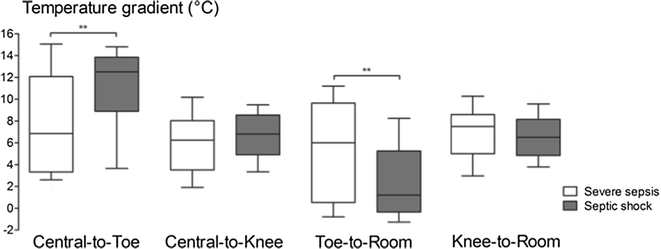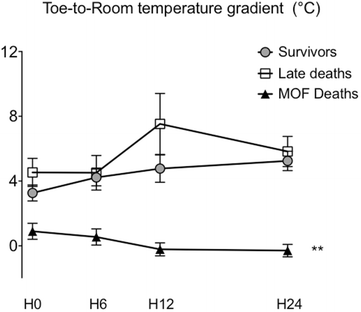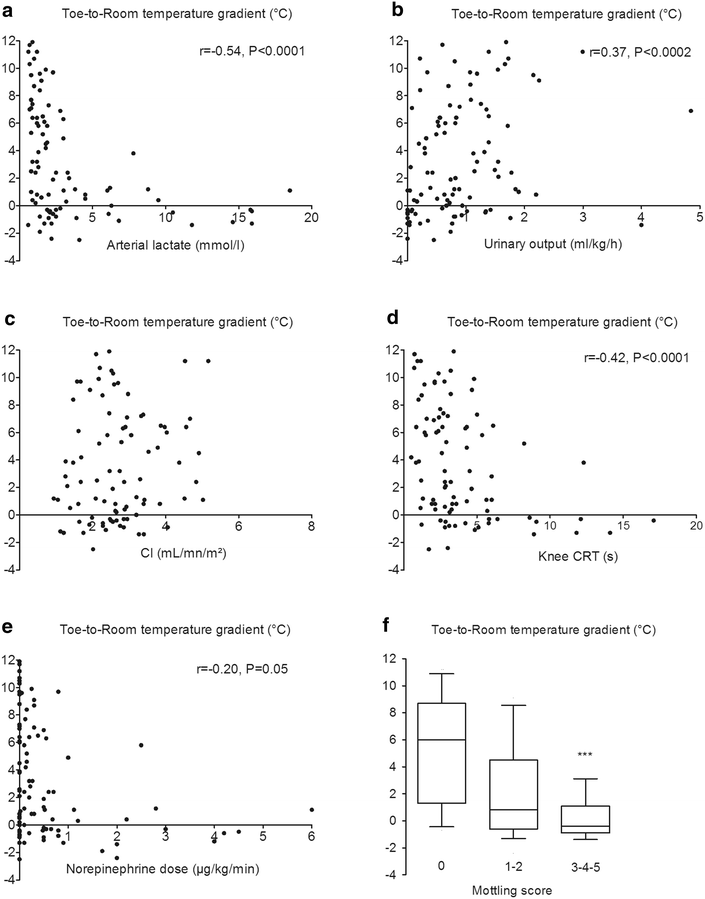Toe-to-room temperature gradient correlates with tissue perfusion and predicts outcome in selected critically ill patients with severe infections
- PMID: 27401441
- PMCID: PMC4940318
- DOI: 10.1186/s13613-016-0164-2
Toe-to-room temperature gradient correlates with tissue perfusion and predicts outcome in selected critically ill patients with severe infections
Abstract
Background: Microcirculatory disorders leading to tissue hypoperfusion play a central role in the pathophysiology of organ failure in severe sepsis and septic shock. As microcirculatory disorders have been identified as strong predictive factors of unfavourable outcome, there is a need to develop accurate parameters at the bedside to evaluate tissue perfusion. We evaluated whether different body temperature gradients could relate to sepsis severity and could predict outcome in critically ill patients with severe sepsis and septic shock.
Method: We conducted a prospective observational study in a tertiary teaching hospital in France. During a 10-month period, all consecutive adult patients with severe sepsis or septic shock who required ICU admission were included. Six hours after initial resuscitation (H6), we recorded the hemodynamic parameters and four temperature gradients: central-to-toe, central-to-knee, toe-to-room and knee-to-room.
Results: We evaluated 40 patients with severe sepsis (40/103, 39 %) and 63 patients with septic shock (63/103, 61 %). In patients with septic shock, central-to-toe temperature gradient was significantly higher (12.5 [9.2; 13.8] vs 6.9 [3.4; 12.0] °C, P < 0.001) and toe-to-room temperature gradient significantly lower (1.2 [-0.3; 5.2] vs 6.0 [0.6; 9.5] °C, P < 0.001) than in patients with severe sepsis. Overall ICU mortality rate due to multiple organ failure (MOF) was 21 %. After initial resuscitation, toe-to-room temperature gradient was significantly lower in patients dead from MOF than in the survivors (-0.2 [-1.1; +1.3] °C vs +3.9 [+0.5; +7.2] °C, P < 0.001) and the difference in gradients increased during the first 24 h. Furthermore, toe-to-room temperature gradient was related to tissue perfusion parameters such as arterial lactate level (r = -0.54, P < 0.0001), urine output (r = 0.37, P = 0.0002), knee capillary refill time (r = -0.42, P < 0.0001) and mottling score (P = 0.001).
Conclusions: Toe-to-room temperature gradient reflects tissue perfusion at the bedside and is a strong prognosis factor in critically ill patients with severe infections.
Keywords: Microcirculation; Outcome; Sepsis; Shock; Temperature gradient.
Figures



Similar articles
-
The use of thermal imaging for evaluation of peripheral tissue perfusion in surgical patients with septic shock.BMC Anesthesiol. 2024 Mar 21;24(1):109. doi: 10.1186/s12871-024-02486-w. BMC Anesthesiol. 2024. PMID: 38515021 Free PMC article.
-
Disparity between skin perfusion and sublingual microcirculatory alterations in severe sepsis and septic shock: a prospective observational study.Intensive Care Med. 2008 Jul;34(7):1294-8. doi: 10.1007/s00134-008-1007-x. Epub 2008 Mar 4. Intensive Care Med. 2008. PMID: 18317733 Free PMC article. Clinical Trial.
-
Hemodynamic and skin perfusion is associated with successful enteral nutrition therapy in septic shock patients.Clin Nutr. 2020 Dec;39(12):3721-3729. doi: 10.1016/j.clnu.2020.03.033. Epub 2020 Apr 2. Clin Nutr. 2020. PMID: 32307194
-
Narrative review: clinical assessment of peripheral tissue perfusion in septic shock.Ann Intensive Care. 2019 Mar 13;9(1):37. doi: 10.1186/s13613-019-0511-1. Ann Intensive Care. 2019. PMID: 30868286 Free PMC article. Review.
-
Macrocirculatory and Microcirculatory Endpoints in Sepsis Resuscitation.J Intensive Care Med. 2021 Dec;36(12):1385-1391. doi: 10.1177/0885066620982585. Epub 2020 Dec 30. J Intensive Care Med. 2021. PMID: 33375916 Review.
Cited by
-
Vitamin C improves microvascular reactivity and peripheral tissue perfusion in septic shock patients.Crit Care. 2022 Jan 21;26(1):25. doi: 10.1186/s13054-022-03891-8. Crit Care. 2022. PMID: 35062987 Free PMC article.
-
Effects of capillary refill time-vs. lactate-targeted fluid resuscitation on regional, microcirculatory and hypoxia-related perfusion parameters in septic shock: a randomized controlled trial.Ann Intensive Care. 2020 Nov 2;10(1):150. doi: 10.1186/s13613-020-00767-4. Ann Intensive Care. 2020. PMID: 33140173 Free PMC article.
-
Assessment of the peripheral microcirculation in patients with and without shock: a pilot study on different methods.J Clin Monit Comput. 2020 Dec;34(6):1167-1176. doi: 10.1007/s10877-019-00423-8. Epub 2019 Nov 21. J Clin Monit Comput. 2020. PMID: 31754965 Free PMC article.
-
The Indian Society of Critical Care Medicine Position Statement on the Management of Sepsis in Resource-limited Settings.Indian J Crit Care Med. 2024 Aug;28(Suppl 2):S4-S19. doi: 10.5005/jp-journals-10071-24682. Epub 2024 Aug 10. Indian J Crit Care Med. 2024. PMID: 39234230 Free PMC article.
-
Approach of minimal invasive monitoring and initial treatment of the septic patient in emergency medicine.Open Access Emerg Med. 2018 Nov 20;10:183-191. doi: 10.2147/OAEM.S177349. eCollection 2018. Open Access Emerg Med. 2018. PMID: 30538590 Free PMC article. Review.
References
LinkOut - more resources
Full Text Sources
Other Literature Sources
Research Materials

